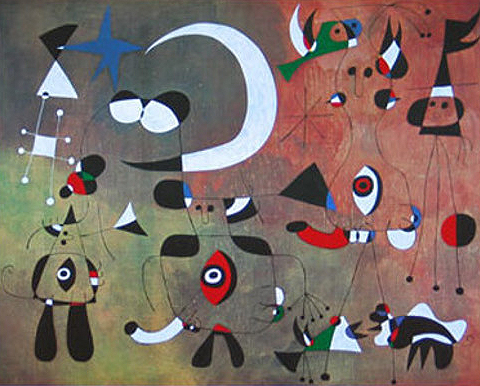Born in Barcelona, Spain in 1893, Joan Miró grew up the son of a watchmaker during the Catalan independence movement.
Coming of age in this environment, a deep-seated sense of liberty and internationalism developed in the artist. Over the years, this resulted in a lifetime of creation that spoke of life, joy, and freedom. In this painting, People in the Night, we are viewing an work that depicts pure, childlike expression. Miró's use of basic organic shapes and bold, primary colours make up his highly personal visual language. At first glance, this language seems simple, yet is deeply symbolic. This language of symbols is a reflection of Miró's personal vision and philosophy. That philosophy is one pertaining to his profound sense of concern regarding the relationship between mankind and nature, which he felt was under threat by modern civilization.
Created in 1949, the imagery in People in the Night is playful and innocent while simultaneously rebelling against the conventions of traditional painting methods. Once described by fellow artist André Breton as 'the most Surrealist of us all', Miró had a true sense of childlike wonder about the world around him and believed that images and ideas for his work lay hidden in everyday things, often seeing shapes appear before his eyes as he lay in bed staring at the ceiling, which he collected in a notebook.
This intensely creative artist's mind, for Jean Miró, may have been the product of so many years of witnessing political turmoil. His native Spain struggled under a dictatorship for almost 40 years and endured the Spanish Civil War. After living and painting in the Normandy region of France, Miró made a narrow escape when he fled to Spain just as the German invasion of France commenced.
The many works created during Joan Miró's long life collectively tell an complicated story of the moods, both dark and joyful, of these difficult times. In works such as People in the Night, looking upon the colourful figures moving about in an open space, with their innocent expressions, there is a reminder that even in difficult times, there is joy and liberty to be found in small things and little moments; that a zest for life continues on. Joan Miró passed away in Majorca, Spain on Christmas Day 1983, leaving behind an international legacy that continues to inspire artists today.




